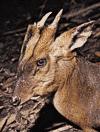- muntjac
-
/munt"jak/, n.1. any of various small deer of the genus Muntiacus, of southern and eastern Asia and the adjacent islands, esp. M. muntjac, of Java, India, etc., having well-developed horns on bony pedicels.2. any of the small deer of the related genus Elaphodus, of China and Tibet, having minute horns.[1790-1800; ( < D) < Sundanese manycak a kind of chevrotain; reason for subsequent application to this deer uncert.]
* * *
or barking deerAny of about seven species of solitary, nocturnal deer, native to Asia and introduced into England and France, that constitute the genus Muntiacus (family Cervidae).Named for their cry, most species stand 15–25 in. (40–65 cm) high, weigh 33–77 lbs (15–35 kg), and are grayish, reddish, or brown. Males have tusklike upper canine teeth and short one-branched antlers. Bony ridges extend from the antler base onto the face. The giant muntjac (88–110 lbs, or 40–50 kg) was discovered in northern Vietnam in 1993–94. Fea's muntjac (M. feae), of Myanmar and Thailand, is endangered, and other muntjac species are threatened. Chinese muntjac (Muntiacus reevesi )Kenneth W. FinkRoot Resources
Chinese muntjac (Muntiacus reevesi )Kenneth W. FinkRoot Resources* * *
▪ mammalany of about seven species of small- to medium-sized Asiatic deer that make up the genus Muntiacus in the family Cervidae (order Artiodactyla).Called barking deer because of their cry, muntjacs are solitary and nocturnal, and they usually live in areas of thick vegetation. They are native to India, Southeast Asia, and southern China, and some have become established in parts of England and France. Fea's muntjac (M. feae), of Myanmar (Burma) and Thailand, is an endangered species.Most species of muntjac stand 40–65 cm (15–25 inches) high at the shoulder and weigh 15–35 kg (33–77 pounds). Depending on the species, they range from grayish brown or reddish to dark brown. Males have tusklike upper canine teeth that project from the mouth and can be used to inflict severe injuries. The short antlers have one branch and are borne on long bases from which bony ridges extend onto the face (hence another common name, rib-faced deer); the female has small knobs in place of antlers.A previously unknown species of muntjac was discovered in the Vu Quang Nature Reserve of northern Vietnam in 1993–94. It was named the giant muntjac because it appears to be larger than other species, with an estimated weight of 40–50 kg.* * *
Universalium. 2010.
